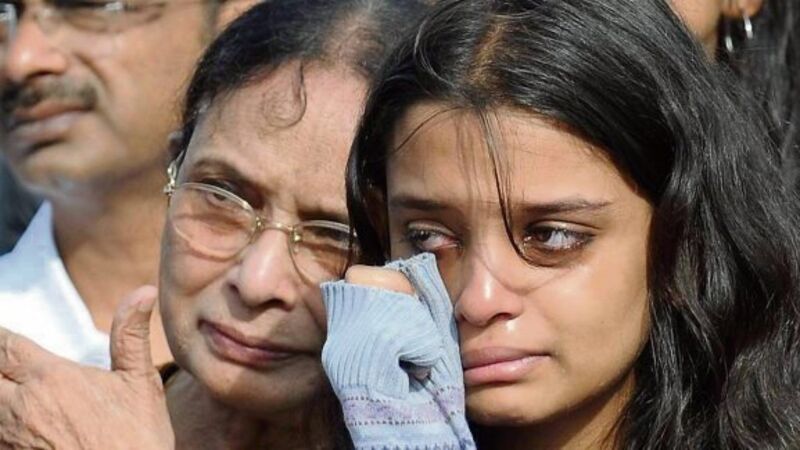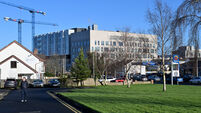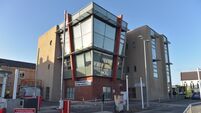VIDEO: Tears and trauma in West Cork and beyond: The Air India crash 30 years on

It was an act of terrorism which was the largest mass murder in the history of Canada. But it took 25 years for that country to accept the greatest loss of Canadian lives at the hands of terrorists had been somehow “relegated outside the Canadian consciousness”.
On a Sunday morning, 30 years ago, Air India Flight 182 exploded over the north Atlantic Ocean, in Irish airspace. Eighty-two children under the age of 13, including six babies, were among the 329 victims.
The majority of passengers were Canadian citizens or had strong connections with the country, although they were of Indian origin.
There were no survivors. Irish Naval Service crewmen entered shark-infested waters to recover bodies. A total of 131 were finally recovered as RAF and Royal Naval helicopters assisted, along with merchant ships and fishing trawlers, about 160km off the south-west of Ireland.
The atrocity will be commemorated in both West Cork and Canada on Tuesday, on the 30th anniversary of the June 23 aviation bombing.
It was the first time a jumbo jet had been blown out of the sky.
Extremists had planned a second attack on an Air India jet. Fortunately, hundreds of senseless deaths were avoided when the device exploded at a Japanese airport. Sadly, two luggage handlers died.
For over two decades, the government of Canada effectively buried its head in the sand on many issues, including a failure of admission that the heinous crime could have been prevented.
It was carried out by Sikh extremists, living in Canada, in revenge for a
government of India operation a year earlier in the Punjab region when hundreds of people, according to official records, died.
The Canadian police and intelligence services had been tracking the extremists for a number of years, and more specifically for a number of months before the 1985 mass murder.
However, they had completely undermined a likely aviation terrorism risk, despite advance warnings by potential informers and surveillance operations.
In one surveillance watch, officers had observed the bombmaker — the only person ever convicted in relation to the terrorism attack — of experimenting with devices just months before the mid-air explosion.
A commission of inquiry found the victims’ families had been left in a limbo by the Canadian government, and had “often been treated as adversaries, as if they had somehow brought this calamity upon themselves”.
It took 25 years for Canada to ‘right the historical wrong’, with prime minister Stephen Harper issuing an apology on behalf of the government.
In 2010, he finally accepted the act of barbarism had been a “Canadian tragedy”. After all, the act of sabotage had been plotted in Canada, the bombs were made there and planted in luggage in Vancouver airport, and, significantly, the majority of victims were Canadians, despite being of Indian ancestry.
Air traffic control at Shannon Airport had raised the alert after the Air India flight, due to stop over in London en route to New Delhi from Montreal, had disappeared from radar screens at exactly 8.13am local time (7.13am GMT).
The victims, including the airline crew of 22, constituted 268 Canadian citizens, 27 British, 24 Indians, and ten others.
In the days that followed the horrific Sunday morning act, hundreds of victims’ relatives arrived into Cork and Shannon Airports as the then Cork Regional Hospital, along with the airport, became nerve centres for a massive recovery operation of bodies and wreckage.
Transatlantic merchant ships and fishing trawlers, along with the Coast Guard, Irish Naval boats, and RAF helicopters played pivotal roles in the recovery of bodies.
Many distraught relatives, seeking to find the nearest land point to where the Boeing 747 disintegrated at 31,000ft, discovered a site at Ahakista in West Cork where a shoreline memorial garden was created. Every year since, locals join relatives of the victims in remembering the disaster.
Air India Flight 182 had been among the aircraft which departed Vancouver on the night of June 22.
A second aircraft, heading to Japan, had also carried luggage containing a bomb. But this planned act of slaughter was foiled when the bomb exploded at Narita Airport in Tokyo before it had been loaded on to an Air India flight.
Canadian lawyer Susheel Gupta, who was just 12 years old when his mother Ramwati Gupti perished in the Atlantic explosion, is a director of the Air India Victims’ Families Association. He said the association, which had campaigned for a public inquiry, was quite pleased with the outcome of a commission of inquiry that was finally set up ten years ago and headed by a retired Supreme Court judge, John C Major.
He said the commission had provided the relatives with their first opportunity to tell their stories of immense sorrow over the death of loved ones and the despair experienced as the government of Canada continually let them down.
Mr Gupta, who is deputy chair of the Canadian Human Rights Tribunal in Ottawa, said the emotional trauma of the tragedy had not only been confined to the relatives.
He said the association had, over the years, met a number of the emergency responders involved in the search for bodies along with the medical teams who had performed post mortem procedures.
“There were many professionals along with civilians involved, the people who were on merchant ships, fishing boats, naval vessels, and other private boats at that time in the Atlantic. Along with the medical and other hospital staff in Cork, we also acknowledge and identify those people as indirect victims of terrorism for the trauma they must have suffered.
“We owe it to ourselves as relatives and to all those other people who suffered trauma without any professional counselling afterwards to have the tools and resources to go forward.” said Mr Gupta.
He added that he was fortunate to have a strong father to guide him and a good network of friends who had provided him with a way to find hope.

Babu and Padmini Turlapati who lost two sons, Sanjay and Deepak on the Air India disaster at the memorial at Ahakista. Picture: Des Barry
Unfulfilled hopes and dreams of seeing their only two children blossom in life shattered the lives of Lakshminarayana (Babu) Turlapati and his wife Padmini from Toronto, who heard of the Air India disaster through a television news item. For them and many others angered by the incompetencies of the intelligence and security agencies, justice has not been done, with the main perpetrators of the horrific mass murder remaining unpunished:
“We had only two children, sons Sanjay and Deepak, aged 14 years and 11 years, respectively, in 1985, and both were in that ill-fated plane Air India 182 that crashed off the coast of Ireland by explosion in midair at 8.13am on June 23, 1985.
“The explosion was caused with bombs placed by sikh extremists in the cargo hold of the plane. The plane had left Toronto on the evening of June 22 and was going to New Delhi in India.
“ I am a chartered accountant and Padmini is a paediatrician, both professionals in our fields. We were working in India before we left for Nigeria in 1973 and worked there for 10 years.
“We immigrated to Canada in 1982 and our goal was to give our sons Sanjay and Deepak a broader perspective and greater opportunities in a new and welcoming multicultural land.
“Our sons had demonstrated academic excellence and strong moral values.
“Sanjay was bright, alert, and mature beyond his years. He wrote poetry which his teacher planned to collect in a book. He had received awards for top academic standing in school.
“Deepak was also very bright, full of life and zest. He was a good negotiator, a good actor who took part in school sponsored children science quiz programmes on television. He too did well in school and was full of compassion.
“Sanjay and Deepak were travelling as unaccompanied children on that ill-fated flight to see their grandparents in India. That was their first visit after we immigrated to Canada.
“We went to sleep and were expecting to hear from our children the next evening after they had reached New Delhi and were received by their maternal uncle.
“Instead, we were woken up by a telephone call very early on the morning of the 23rd from a friend asking whether our children boarded the Air India plane that left the previous evening.
“When we confirmed ‘yes’, we were advised to see television to check a news item that an Air India plane that left Toronto on the night of the 22nd was missing from radar near Shannon, Ireland.
“The news was devastating and we heard the first account of the missing plane watching television and that a search was on to locate the plane with the help of ships that were in the vicinity of the area.
“We finally heard the tragic end only watching television and through friends who too watched television at that time.
“No one from Air India nor any government agency had contacted us about the missing plane or loss of lives.
“Our lives were shattered and we felt [the] end of our hopes and dreams of bringing up our children and their growing into adulthood.
“We felt [a] total void in our lives and no words can describe the agony we went through the next few days not knowing what had actually happened and not getting any moral support.”

The captain of the lead search vessel LÉ Aisling had a rather unusual way of de-stressing his crew, who had to pull bodies from the water just feet from circling sharks.
Captain Jim Robinson was the 35-year-old captain of the vessel at the time and, 30 years ago, there was no such thing as post-traumatic stress counselling.
His method of counselling after the body recovery mission was to get the crew to ‘drink dry’ the Haulbowline naval base and, in the process, talk to each other about how they had been affected.
Now retired, after completing his career as second-in-command of the Naval Service, the memories of what he and his crew encountered after the Air India bombing are still firmly etched in his mind.
Capt Robinson said he wanted to single out three “remarkable men”, who had been tasked with recovering the bodies and refused to be relieved of duty, as they toiled for 12 hours, some of the time surrounded by dangerous sharks. They were petty officer Mossie Mahon, leading seaman John McGrath and able seaman Terry Browne. They were all later awarded DSMs (Distinguished Service Medals) for the heroic part they played in the recovery operation.
Capt Robinson said a number of blue sharks, each around 2 metres long, started appearing in the waters around the recovery site around midday.
The divers had been in the water lifting the bodies onto small Gemini boats, as they watched the shark fins pass by, menacingly. Eventually, they relented to an order from Capt Robinson to get out of the water and to pull the bodies onboard, instead.
At the time, Capt Robby McDougall, master of the merchant ship Laurentian Forest, which was the vessel at the scene of the rescue operation, had told the media of the heroism of the divers.
“It was a very brave thing for the men to do,” Capt McDougall had said. “I wouldn’t have done it.”
LÉ Aisling should have been off the west coast that day, but Capt Robinson decided the Spanish trawler fleet was more likely to be found in the southwest. They had arrested one for illegal fishing when the aviation bomb alert occurred.
“We got the call that an aircraft was down and, initially, we thought it might be a Cessna or something. Nearly two hours later, we were informed it was a jumbo jet, so the cooks were preparing soup and we were getting blankets ready onboard, as we really hoped we would find people still alive,” he said.
However, he and the 45-strong crew didn’t know the plane had been blown up mid-flight.
“When we got to the scene, we realised this was going to be a recovery operation rather than a rescue operation.
“The whole crew were remarkable on the day. I had been the eldest on the ship, at 35, and there had been a number of teenagers. It was humbling from my point of view how, to a man, they mucked in.”
“As a military officer in command, you always wonder if, put to the test, you can function and lead people. I remember thinking at the time ‘this is your moment, you’d better do your job’.”

Monday:
West Lodge Hotel: Ecumenical service Minute’s silence for victims of Berkeley before ceremony commences
Tuesday memorial service:
Assemble at monument at Ahakista
: Families assemble around sundial
: One minute of silence.
Silence broken with chantings by victims’ families.
Laying of a wreath in memory of all the 331 victims by the families
Laying of a wreath in memory of victims by Michael Murphy on behalf of Ahakista Memorial Association.
: Fr Gerard Galvin, Can Paul Willoughby and Dr Shashi Sharma.
Children’s choir from Ahakista National School
Public representatives laying wreaths - Indian Minister for External Affairs Minister V K Singh Indian Ambassador to Ireland Radhika Lal Lokesh, Canadian Minister for Justice Peter MacKay, Canadian Ambassador to Ireland Kevin Vickers, Irish Minister for Foreign Affairs, Charlie Flanagan, Mayor of Cork Co Council Cllr Alan Coleman
Public representative Speeches - Cllr Coleman. Minister Flanagan, Minister Singh, Minister McKay.
Other speakers - Representatives of Victims’ families Padmini Turlapati, Deputy Lord Lieutenant Hari Shukla, Mary Ryan, acting divisional manager Cork County Council. Vote of Thanks: Narayana Turlapati
Canadian poet Renée Sarojini Saklikar’s aunt and uncle were murdered in the bombing of Air India Flight 182.
A lawyer from British Columbia, she will present a reading this evening in Skibbereen from her book Children of Air India, winner of the 2014 Canadian Authors Award for best poetry book.
In her presentation at the Uillinn: West Cork Arts Centre at 7pm, she will contextualise the reading through a short talk “History, Grief, Remembrance,” on the inter-connections between the people of Cork and Canada vis a vis the bombing and recovery three decades ago.
This evening’s event is free and open to the public.
“My family will never forget the compassionate care given to us by the people of Cork, in the days just after the bombing: search and recovery crews as well as nurses and doctors, and many local people, reached out with kindness and incredible support and continue to do so till this day,” says Saklikar.
Her poetry about the Air India bombing will be adapted for music and voice later this year in an Irish-Canadian production supported by Culture Ireland and featuring the work of Irish composer Jürgen Simpson and Irish director Tom Creed.
Saklikar will attend tomorrow morning’s 30th anniversary commemoration at the memorial site at Ahakista on the Sheep’s Head peninsula.
In her first book of poems, Children of Air India: un/authorized exhibits and interjections, Saklikar presents a powerful and deeply personal collection.
It breaks new ground in her approach to the Canada-Air India saga. It is animated by a proposition: that personal and shared violence produces continuing sonar, an echolocation that finds us, even when we choose to be unaware or indifferent.
She says “as a creative writing instructor and a community supporter and activist, it is a great gift to engage with people through and with poetry”.
Saklikar had the opportunity to visit West Cork last year.
She said: “It was very moving to situate the Air India incident within the context of the greater Irish narrative, as well as to hear from folks with connections to the 1985 bombing and its recovery operation in Cork.”















